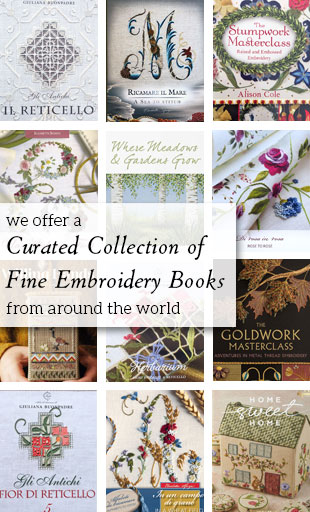Since I’m exploring a bit of crewel embroidery these days, I thought I’d share some resources with you for different things relevant to crewel embroidery.
You’ll find that most of these resources are relevant to other types of hand embroidery as well, though, so even if you aren’t into crewel, you’ll probably find something here that entices you!
Transferring Your Embroidery Design
For transferring crewel designs, a reader suggested using a sepia colored micron pen, as it will be less likely to show (with anything except white). I totally agree! But sepia colored art pens are not always available at craft and art stores, so they’re harder to come by.
I just ordered a couple from Blick Art Materials. They have both the Sakura Micron Pens and the Prismacolor Illustration Markers. I like both. A product search for “micron” pens will bring these up.
A light table is also a great instrument for transferring designs. If you like to embroider your own designs instead of pre-printed designs, investing in one of these is a good idea. You can use it for all kinds of applications – not just for tracing onto fabric.
I use mine for lots of things – card-making, embossing, designing layouts for needlework, etc.
Fabric for Crewel Embroidery
Traditionally, linen twill is favored for crewel work. Besides linen twill, you can also use a plain weave linen.
I like Legacy linen (from Access Commodities) linen twill. It’s lighter than the traditional heavy-weight twill used with many examples of historical crewel work today. This makes transferring a design by tracing a whole lot easier!
But that’s not the only reason I like it. It’s a fine, sturdy fabric in a pleasing white-ish creamy color – ivory – and it just makes a lovely background. It’s also strong as all get-out, so it works well as an alternate fabric for goldwork and the like, too.
If you’re looking for plain-weave linen, Strathaven linen is great as a ground fabric, too.
Update, 2017: The sales mentioned in the title were ages ago (back in 2010), so that information has been deleted.
You can still find the products mentioned above through different sources:
Sakura Macron art pens in sepia are still available through Blick’s online or at local art and craft stores.
Light boxes – I have this one now, that I reviewed a while ago. You’ll find several alternatives at the end of the review, too.
Linen – You can find both Strathaven linen and Legacy linen twill in the US at local or online needlework shops that carry goods from Access Commodities.







Since you mentioned marking pens (and I know you've addressed the subject before but I'm having trouble finding it), I recently bought a couple of Australian goldwork kits that called for using white gel grip pens to mark on white fabric.
I recall that you said white on white was hard to see . . . but have you ever used gel grip pens in general to mark fabric? Any thoughts on those?
Hi, Janice –
I haven't used the gel pens. I'm not quite keen on gel pens, whether I'm writing with them on paper, or working with them in any other application. I don't know how well they work on fabric. I would suppose that the designers would know, though, what works, and so if they recommend that pen, there must be a reason for it.
I've used white (chalk pencil) to transfer on a very light pale gold silk and also on white silk. The white chalk, because of the contrast with the shiny silk, is actually easy to see. I can't imagine that this would work on linen, but it certainly works when there is a contrast between the fabric and the transfer method.
Now, the nice thing about it is the fact that, even if you don't cover it completely, the white transfer is not noticeable once there's embroidery around it. It just sort of blends in. So you don't have to feel at all "stressed" about covering transfer marks when working with white-on-white transfers!
Hope that helps!
MC
Mary – thanks for the info on white chalk pencil. I will consider it for these projects depending on what the designer says about the gel pen. I e-mailed her this morning and will post what I find out.
I also like getting your opinion on such things because of the extent of your experience: you're kind of a Consumer Reports/Good Housekeeping Seal of Approval arbiter for needlework products and techniques!
Thanks so much for the heads up…I just ordered some Legacy linen twill. Can't wait to try it!
Hhhmmm. I'd like to see a photo of the whole rooster now that he's got the long and short stitched shading in his tail. Even in the closeup the change from dark to light blue doesn't seem shocking to me.
I love the way his plumage looks…although I probably would not use the pink…but that is totally a difference in color taste call and not a critique of your choice.
I do appreciate that you are pulling from your stash as I try to do that whenever possible….
A thread used up from the stash is a dollar earned! 😉
Benjamin Franklin probably would have said that if he were a stitcher 🙂
Hugs, Marlon